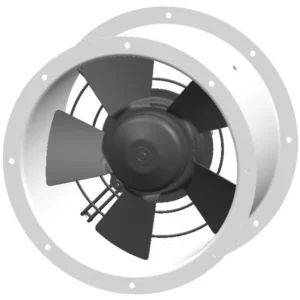Axial flow fans contribute to energy efficiency in various applications through their design, control systems, and ability to move large volumes of air with relatively low power consumption.
Here are several ways in which axial flow fans enhance energy efficiency:
- High Airflow Rates with Low Power Consumption:
- Axial flow fans are designed to move large volumes of air efficiently. Their aerodynamic design and axial airflow path enable them to achieve high airflow rates with comparatively lower power consumption, making them energy-efficient.
- Suitability for Ventilation and Cooling:
- Axial flow fans are commonly used for ventilation and cooling purposes. By efficiently circulating air in spaces, they help maintain comfortable temperatures, reducing the reliance on mechanical cooling systems such as air conditioners. This can lead to significant energy savings.
- Variable-Speed Controls:
- Many axial flow fans are equipped with variable-speed controls. Adjusting the fan speed based on the specific cooling or ventilation requirements allows for better energy management. Fans can operate at lower speeds during periods of lower demand, conserving energy.
- Efficient Airflow Distribution:
- Axial flow fans are effective at distributing airflow evenly over large areas. This ensures that conditioned or fresh air reaches all corners of a space, reducing the need for supplementary fans and improving overall energy efficiency.
- Integration with Building Management Systems (BMS):
- In commercial and industrial applications, axial flow fans can be integrated into Building Management Systems (BMS). BMS allows for centralized control and automation, optimizing fan operation based on real-time conditions and occupancy. This contributes to energy efficiency by aligning fan operation with actual demand.
- Use in HVAC Systems:
- Axial flow fans are commonly integrated into Heating, axial flow fan manufacturers Ventilation, and Air Conditioning (HVAC) systems. Their efficiency in moving air allows HVAC systems to distribute conditioned air throughout buildings more effectively, reducing the workload on heating and cooling equipment.
- Application in Heat Exchangers:
- Axial flow fans are often used in conjunction with heat exchangers for processes such as air-cooling. Their efficient operation contributes to the effectiveness of heat exchange systems, improving overall energy efficiency.
- Efficient Exhaust Systems:
- In industrial applications, axial flow fans are employed in exhaust systems to remove hot or contaminated air. Their ability to handle high volumes of air efficiently ensures that exhaust processes are carried out with minimal energy consumption.
- Optimized Fan Blade Design:
- Advances in fan blade design, including the use of aerodynamically efficient profiles, contribute to increased energy efficiency. Well-designed blades reduce drag and improve overall fan performance.
- Regular Maintenance Practices:
- Proper maintenance, such as cleaning blades and ensuring optimal performance, is crucial for energy efficiency. Well-maintained axial flow fans operate more efficiently and consume less energy.
By providing effective and efficient airflow, axial flow fans contribute significantly to the energy efficiency of various applications, ranging from industrial processes to HVAC systems and commercial ventilation. The ability to tailor their operation to specific needs and integrate them into sophisticated control systems further enhances their overall energy performance.

Comments